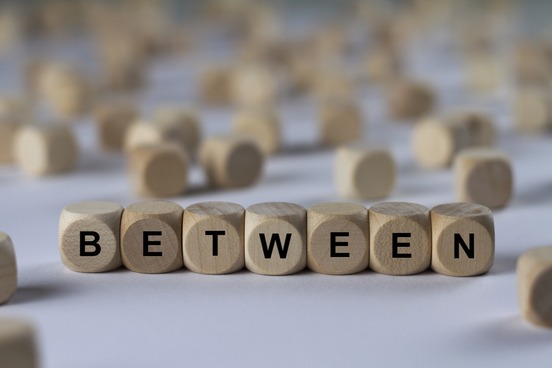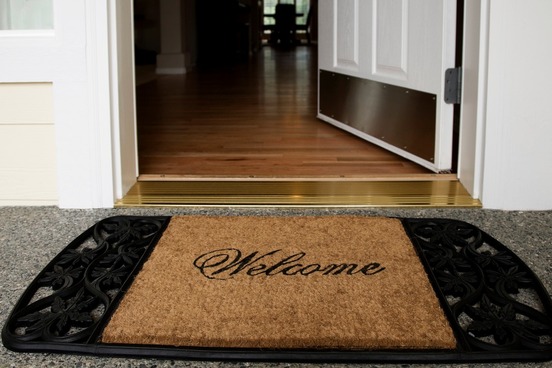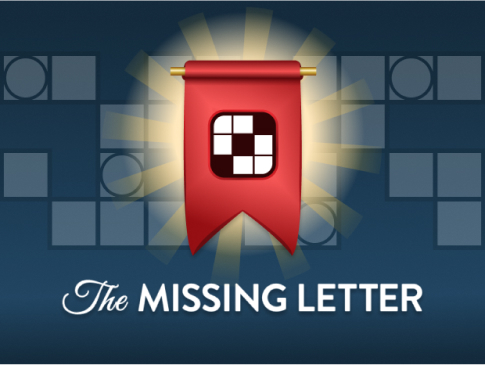
In-between
When we say that someone or something is in between two other people or things, we mentally place them in the middle, with something on either side. After all, between refers to that space in the middle, right?
It does—but it hasn't always. The Old English word that eventually became between is actually made up of two parts: the prefix be- and the word twēonum. Twēonum is related to twā, the Old English word that gave us "two"; it's the dative plural form of an old distributive numeral that might be best translated as "two each." You'd expect that be- would mean "in," but it doesn't: betwēonum is literally "near two each." In its earliest uses, it wasn't always in reference to the intermediary position of two places, things, or people. It was also used to express reciprocal action by two people towards each other.
Though some claim that in between is redundant, we have evidence of it going back to at least the 1500s, if not earlier—one of our early uses notes that "The Sea brake in between Wisbich, and Walsockenne." The collocation was so common, in fact, that it eventually gave rise to the hyphenated in-between, a noun that refers to an intermediary.

Threshold
One of the most common in-betweens we encounter every day is the threshold. Whenever you leave your house, walk from one room to another, or enter a building, you are crossing a threshold.
Threshold is an old word, dating back over 1,000 years in English, and its origins are slightly obscured. Its Old English ancestor threscwald or threscwold is cousin to the verb that gave us thresh, and this verb in turn refers to separating grain from chaff by beating it with something (like a stick or a flail). But there's nothing in the historical record that directly ties threshing to the threshold.
The threshold of a door is actually the horizontal floor piece that you walk over whenever you move through a doorway, and this is one of the uses we give it today. But the earliest uses of threshold refer to a different type of boundary: an Old English translation of Boethius's De Consolatione Philosophiae uses the word in a sentence about how the sea was made so that it didn't overstep the "threshold," or boundary, of the earth. We still use threshold with that broader "boundary, limit" sense today:
As members left a meeting about the bill, many said they were encouraged by their first impressions of the text but were hesitant to say if it would clear the 50 vote threshold for passage.
—Veronica Stracqualursi, Adam Kelsey, and Ali Rogin, ABCNews.com, 23 June 2017

Betwixt
Betwixt is now old-fashioned sounding, but it's a close cousin of between: the -twixt of betwixt traces back to the same root as the -tween of between. Not surprisingly, betwixt means "between."
It may seem odd that between and betwixt both exist, but in Old and Middle English, these compounds abounded. The Oxford English Dictionary lists between, betwixt, betwixen, betwihen, bitwih, and bitweies as variants on this theme, and all related to each other. Most of them passed out of common use by the 1400s, though betwixen stuck it out until the 1800s and betwixt still survives in limited use.
Betwixt often shows up in the old-fashioned phrase betwixt and between. It means "neither one thing or the other," and is a prime example of redundancies which settle into established use.

Devil and the deep blue sea
Many phrases that evoke in-between-ness also situate the speaker between two undesirable end points, like the devil and the deep blue sea.
Ocean lovers may object to that characterization of the deep blue sea, but this is a later change to the original phrase, which was the devil and the dead sea. Why the devil, and why the dead sea? No one knows. The phrase first shows up in a 1621 English translation of a collection of Latin and Greek proverbs compiled by Erasmus. It's the translation of the medieval Latin proverb a fronte praecipitium, a tergo lupi—which has nothing to do with the devil or the sea. A better translation of the Latin would be "a precipice in front, wolves behind."

Scylla and Charybdis
Between the devil and the deep blue sea has an echo in the phrase between Scylla and Charybdis. The latter phrase also refers to being stuck between two undesirable (and dangerous) options. The phrase appears with this meaning in the mid-1500s.
It draws from Greek mythology. In Homer's Odyssey and Ovid's Metamorphoses, Scylla is an immortal monster with six heads, each on a long neck, and twelve feet, who lives in a cave near a narrow strait and feasts on those who are unfortunate enough to sail by. Odysseus encountered her in the Odyssey as he sailed through a narrow strait; she ate six of his men. On the other side of the strait was Charybdis, another immortal monster. According to Homer, she lived under a fig tree near the shore and swallowed the sea three times a day, thereby creating a dangerous whirlpool with shifting currents. A shipwrecked Odysseus escaped her by clinging to a tree and waiting for her to spit back out an improvised raft. The pairing of Scylla and Charybdis in mythology gave later English speakers an easy shorthand to refer to being stuck in the middle of a dangerous or difficult situation.
Eventually, Scylla and Charybdis were associated with the Strait of Messina: a narrow channel between Sicily and Italy known for its rocky coastline and dangerous currents. A prominent outcropping on the Italian mainland is known as the Rock of Scylla, and some navigators throughout history have noted that the currents in the strait do form a whirlpool on the Sicilian coastline opposite Scylla.

Interstice
Sometimes the in-between isn't about what's there; it's about what's not. Interstice is a technical word that came into written use in the 1400s, and our earliest evidence of it refers to studying "the interstice of sterres [stars]." In case we aren't sure what interstice refers to here, the translator helpfully glosses it for us as "the space bytwene."
Interstice went from macro to micro in use: in the 1600s, we have evidence of interstice used to refer to "the place between the browes, the very seat of reason"; in the 1700s, we read about the "interstices of water," which are "always found full of air"; and in the 1930s, interstice was applied to the nonmetal atoms or ions that were situated in the spaces of a nonmetal crystalline lattice. In current use, interstice is used to refer to a small space between things, and it appears quite often in the plural (interstices). It's common in the sciences.

Liminal
Not all in-betweens are static. Liminal is a word that, in its most common extended sense, refers to a state, place, or condition of transition: the liminal state between waking and sleeping, or between life and death.
When liminal first appeared in written use, it had a very specific meaning that referred to something (such as a physical stimulus) which was just barely perceptible, or just barely capable of eliciting a response. This meaning is still in use today in constructions like "liminal auditory stimuli." The word is the adjectival offspring of the noun limen, which refers to the point at which a physiological or psychological effect begins to be produced, and was borrowed wholesale from Latin, where it means "threshold."
While liminal appears primarily in formal or academic writing and may be unfamiliar to many, limen is also the root word of the more common subliminal ("below the threshold of perception").

Transition Words
'Besides,' 'furthermore,' and 31 other words to use in between thoughts and ideas.
SEE THE LIST >





